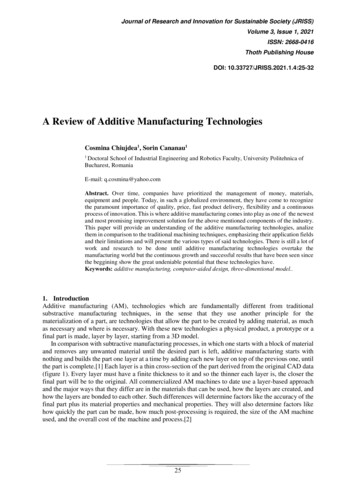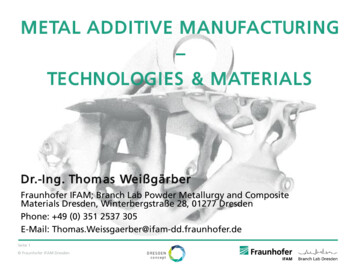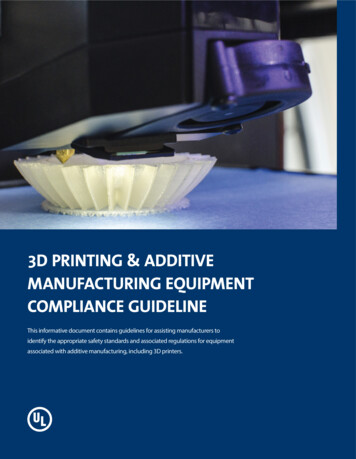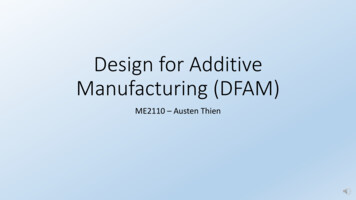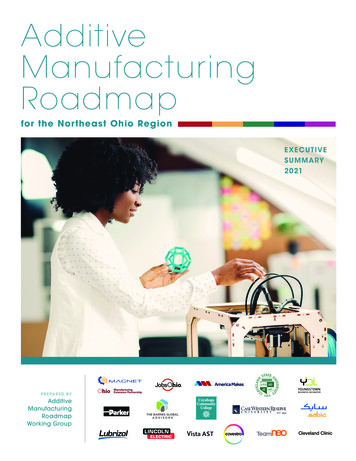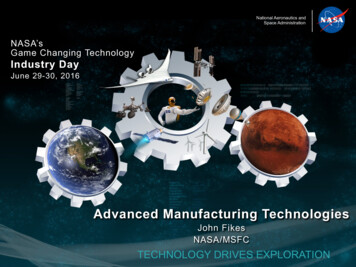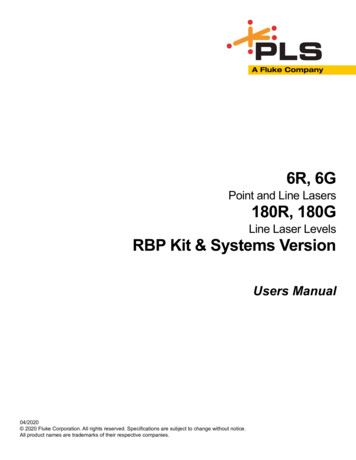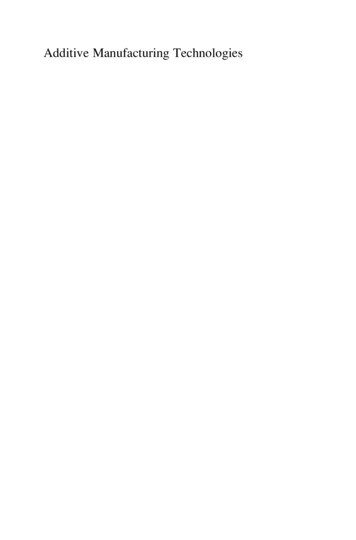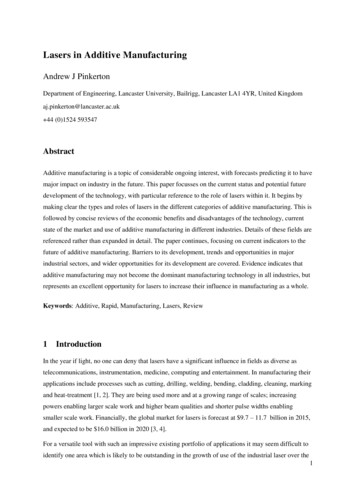
Transcription
Lasers in Additive ManufacturingAndrew J PinkertonDepartment of Engineering, Lancaster University, Bailrigg, Lancaster LA1 4YR, United Kingdomaj.pinkerton@lancaster.ac.uk 44 (0)1524 593547AbstractAdditive manufacturing is a topic of considerable ongoing interest, with forecasts predicting it to havemajor impact on industry in the future. This paper focusses on the current status and potential futuredevelopment of the technology, with particular reference to the role of lasers within it. It begins bymaking clear the types and roles of lasers in the different categories of additive manufacturing. This isfollowed by concise reviews of the economic benefits and disadvantages of the technology, currentstate of the market and use of additive manufacturing in different industries. Details of these fields arereferenced rather than expanded in detail. The paper continues, focusing on current indicators to thefuture of additive manufacturing. Barriers to its development, trends and opportunities in majorindustrial sectors, and wider opportunities for its development are covered. Evidence indicates thatadditive manufacturing may not become the dominant manufacturing technology in all industries, butrepresents an excellent opportunity for lasers to increase their influence in manufacturing as a whole.Keywords: Additive, Rapid, Manufacturing, Lasers, Review1IntroductionIn the year if light, no one can deny that lasers have a significant influence in fields as diverse astelecommunications, instrumentation, medicine, computing and entertainment. In manufacturing theirapplications include processes such as cutting, drilling, welding, bending, cladding, cleaning, markingand heat-treatment [1, 2]. They are being used more and at a growing range of scales; increasingpowers enabling larger scale work and higher beam qualities and shorter pulse widths enablingsmaller scale work. Financially, the global market for lasers is forecast at 9.7 – 11.7 billion in 2015,and expected to be 16.0 billion in 2020 [3, 4].For a versatile tool with such an impressive existing portfolio of applications it may seem difficult toidentify one area which is likely to be outstanding in the growth of use of the industrial laser over the1
next decade. However, one application has been singled out an invention that could remake the worldand constitute a new industrial revolution [5, 6]. Alternatively, in more detail, a revolutionarytechnology likely to restructure supply chains, relocate production facilities and profoundly alter thegeopolitical, economic, social, demographic, environmental, and security landscapes [7, 8]. Thatprocess is additive manufacturing (AM). Additive manufacturing began as a rapid prototypingtechnology, suitable for producing haptic models, and developed into what it is today: both a rapidtooling and a manufacturing technology, capable of producing fully functional parts in a wide rangeof materials, metallic, non-metallic and composite.This paper then looks at additive manufacturing, the way it is likely to develop in the future and therole of lasers in it.2Additive Manufacturing2.1Lasers in Additive ManufacturingAdditive manufacturing processes are typically broken into seven categories according to ASTMStandard F2792 [9], as shown in Table 1. The operation of different AM systems and the relativeadvantages and disadvantages of the different technologies are described and reviewed in theliterature (e.g. [10-13]). Although not holding a monopoly over AM, it is clear from the classificationthat lasers are required for three out of seven of the major categories and two out of three processcategories with the capability to manufacture metallic components.Table 1. Categories of Additive manufacturing, classified according to ASTM Standard F2792 [9]See end of paperThe development of AM systems into user-friendly, commercial units plus the need for safety, meansthe laser within them is not always obvious. Further, during AM of metals it is usually necessary toshield the build point from harmful oxidation, either by performing the whole operation in an inertchamber or using blown inert gas, requiring further removal of the user from the ‘sharp end’ of themanufacturing. To clarify exactly which types of lasers are used in AM, Table 2 lists some laserbased AM processes and systems and their lasers.Table 2. Some major manufacturers of additive manufacturing equipment and their lasers2
CategoryDirected energydepositionPowder bed fusionVatphotopolymerisationManufacturer: systemsLaserOptomec Inc.: LENS series400 - 1000 W fibre laserTrumpf GmbH: TruLaser seriesTruDiode diode laser, up to 6 kW (600nm)Oerlikon Metco Group:MetcoClad systems1 - 6 kW diode laser3D Systems Inc.: ProX, sProand ProX SLM systems30 - 200 W CO2 laser (forthermoplastics)50 – 500 W fibre laser (for metals)EOS GmbH: EOSINT, EOS Mand PRECIOUS M machines30 W, 70 W or 2 x 50W CO2 lasers (forthermoplastics)200 W - 1 kW fibre laser (for metals)SLM Solutions GmbH: SLMsystems400 W - 2 x 1000 W fibre laser (formetals)Renishaw: AM250200 W or 400 W fibre laser3D Systems Inc.: ProJet andProX SLA rangesSolid-state frequency tripled Nd: YVO₄laser (354.7 nm), up to 1.5 WEnvisiontec: Perfactory, Ultra,Xede, Xtreme, 3D-BioplotterrangesNot specifiedClearly, existing commercial AM systems currently utilise a wide range of lasers technologies.Powers range from around 1 W to 6 kW, and wavelengths from the ultraviolet (354.7 nm) to theinfrared (10.6 um). Requirements vary from process to process, but the need to match SLA lasers withthe polymer absorption spectrum, the use of different lasers for different materials in the powder bedfusion bed category and the use of the shorter wavelength diode laser, despite poorer beam qualitythan the fibre laser for directed energy deposition (DMD), indicates absorption is a major factor forlaser selection throughout. Use of systems with powers greater than 6 kW have also beendemonstrated (e.g. [14]) and some industrial ‘home-made’ systems also exist, particularly in the DMDcategory.2.2Additive Manufacturing ProductionOne of the reasons use of AM is forecast to increase at such a rapid rate is that it expands theboundaries for a design engineer by offering a profoundly different approach to traditional subtractivemethods. This can also allow a greater range of components to be made as a single part, reducing thematerial required and need for joining, by whatever means. However, these benefits can be negated byhigh costs.3
There are a number of factors that contribute to the unit production price of an AM part, some ofwhich can be related to the volume of production and others to the degree of complexity andcustomisation of the part [15]. The former can be broken down to material cost, machine cost, buildtime, energy consumption, labour and indirect costs [16, 17]. Despite the greater material efficiencytypically achieved, material costs are high because the raw material can be more expensive than forconventional processes. This is particularly the case for metallic parts, produced via DMD, SLM orSLS. For example, Atzeni et al [18]. calculated the material costs needed for a sintered aluminiumalloy part to be ten times higher than those for the conventionally produced part [18]. Machine costsare another large contributor to the unit cost, and typically the single largest cost for polymeric AM.Different studies have calculated their contribution to be between one-quarter and three-quarters ofthe costs of a part, with the three-quarter contribution coming when building using vat polymerisation[19-21]. Build time, energy consumption and labour cost make up a smaller components of overallcost and can all be minimised by using the machines efficiently, which for most processes meanseffectively using the whole of the available build space to maximise solid:cavity volume ratio.Currently the amount of energy consumed when producing the same part by AM can still be greaterthan that when using conventional manufacturing processes, often due to the longer process times.Studies have found that SLS and 3D printing are less energy efficient than injection moulding at allbut low production volumes [42, 58]. Sreenivasan and Bourell [22] identified major consumers ofenergy in SLS of nylon materials to be chamber heaters (37 %), stepper motors for piston control (26%), roller drives (16 %), and the laser (16 %). Preparation and postprocessing costs are not includedin many models, but Lindemann et al [21] estimated them to be the third largest contributor to overallcosts after the machine and materials. The indirect costs such as factory overheads associated with theproduction can be assigned in different ways, accounting for factors such as mixed part production[20, 23] but for any commercially viable organisation are much lower than direct costs.Taking all these costs together, what is most evident is that in a production environment theeconomies of scale with AM are insignificant compared with traditional methods, leading to Figure1(a) (generalised from [8, 19-21, 24]). The current position of the ‘breakeven’ point due to the highAM machine, material, preparation and postprocessing costs mean large parts, high productionvolumes or rates, or high accuracy and surface finish quality typically render AM production moreexpensive than traditional manufacturing [25-27], although it must be remembered what is defined as‘high production volume’ varies considerably from industry to industry.The degree of complexity and customisation of the part has a significant contribution to theproduction cost of a traditionally manufactured part. Greater complexity can lead to increasedmachining time, operator time, additional tooling, need for custom tooling, more extensivecertification, increased scrap, and the need to subcontract parts that cannot be made in house. Incontrast, complexity of AM parts incurs minimal additional costs and any customisation can be done4
digitally and without the need for additional tools, again incurring minimal cost [15]. This leads toFigure 1(b), which shows that AM is better suited for parts with high complexity and/orcustomisation. Customised parts also help gain market advantage and command a premium price [5,28, 29].Figure 1. (a) Unit production cost for additive and traditional manufacturing; (a) against productionvolume; (b) against product complexity or customisation (adapted from [8, 15, 19-21, 24])Beyond production, the effect of AM on the supply chain varies considerably from business tobusiness, but there are many situations where it can impart savings, ether directly or by acting as anenabling technology for another process. At the beginning of 2011, the sum inventory in themanufacturing industry was 537 billion (equal to 10 % of that year’s revenue) [17]. This ties upcapital and building space (requiring maintenance, insurance, security etc.) and risks productsdeteriorating or becoming obsolete. Additive manufacturing has the potential to reduce this because,provided an inventory of suitable materials is available, it allows a wide range of parts to be producedon demand with no cost penalties for the rapid response. Another area of potential costs savings is5
transport costs. Additive manufacturing allows for the production of fewer, more integrated partsmeaning there are simply fewer parts to transport.An indirect benefit of AM, and potentially a very significant one, it that it is an enabling technologyfor remote direct digital manufacturing (DDM) [30]. Manufacturing closer to the point of sale usingcentrally transmitted data eliminates the need for part transport entirely and reduces the vulnerabilityto supply disruption for critical parts. The same on-site production method can then be used with thepart (or one produced centrally) for rapid on-site production of replacement components. Althoughthese factor can be overriding in same cases, for example use of a 3D printer in the InternationalSpace Station [31], analyses have indicated that in most circumstances AM machines are toospecialised and expensive for this model to be cost effective at present [32, 33].2.3The Additive Manufacturing MarketAdditive manufacturing is currently a 2.2 billion trade with sales of products and services predictedto exceed 6 billion by 2017 [34]. However, the uptake varies greatly across industries. It has hadmost penetration into the aerospace, automotive, electronics, and medical industries [27, 35], but otherpromising industries where it is used have been identified as armaments, furniture, jewellery, sports,speciality foods, surgical devices, textiles, toys, and tools and mould making [36].In the first of these, the aerospace industry, metal AM techniques have been used for applicationssuch as structural part, turbine blade and fuel injection nozzle manufacture and also for repair of wornblade tips and seals. Additive manufacturing can be more cost effective than traditional methodsbecause the aerodynamic and weight-optimised shape of these parts means that with current methodsbuy-to-fly ratios can be low and the materials used are costly [37]. The exact savings versustraditional machining vary with market conditions: in one scenario they were estimated to be of theorder of 15% and this is expected to increase with time [38, 39].In the automotive industry it is currently cost effective to produce prototypes such as cylinder heads,brake rotors, and rear axles for testing via AM [40] and AM is also used in motor racing and for someluxury sport cars, for example intake manifolds, cylinder heads by Lamborghini [41]. However, 90.6million motor vehicles were produced in 2014 globally [42] and the low production speed of AM iscurrently a major disadvantage for wider deployment in this industry. The industry does howevermake use of Rapid Tooling. Rapid Tooling is well developed within the tooling and moulds makingindustry generally and there are a range of different techniques including vacuum casting, metal spraytooling, and Keltool [43]. The short lead time of AM tooling can significantly reduce cost and time tomarket and improve the functionality and productivity of moulds [44].6
Additive manufacturing technology is used in multiple ways in the medical and medical aidindustries, which is ideally suited to the strength of AM in producing low volume, personalised parts[27]: In dentistry to produce digital prostheses such as bridges and crowns, invisible dental bracesand alignment devices [45-47]. In surgery to produce minimally invasive surgical tools, microtissue debriders, monolithicallyfabricated articulated biopsy forceps etc. [48]. To manufacture artificial bone like material for joint replacement surgery, bone graftingorthopaedic implants and drug delivery devices [49, 50]. Integration of the scanning, designingand manufacturing stages allows complex and personalised biomedical parts to be obtainedand such an approach and can significantly shorten the design and delivery cycle [51]. As a rapid prototyping technology to produce biomodels for diagnosis, surgical training andpre-surgery planning. This is currently the single largest application in acute healthcare [52]. To produce medical prostheses for example trans-tibial prosthesis [27] and body conformalaids, for example hearing aids [10]. The Additive Manufacturing of hearing aids is very wellestablished, with almost global saturation.Additive tissue manufacture has been used to produce simple biological tissues and organs but is at anearly technology readiness level because both the manufacture (including multiple cells and materials)and design (to incorporate vascularization) of such structures is complicated. Structures are currentlyhydrogel based which lack the strength for larger parts and matching degradation to tissuedevelopment is difficult [53].The electronics industry is another growth area for AM. From an electronic circuit production point ofview, AM mean there is no need for mask preparation like conventional lithographic-based processes.This means microsystems can be prototyped faster, reducing development time and allowing moredesign iterations and optimization. With process optimization, electronics printing may also be moreenergy efficient than traditional lithography, although there is currently a lack of process data in thisrespect [54]. In addition to circuits, micro-electronic components can be produced; 3D manufacturevia AM offers the functional advantage over 2 or 2.5D methods of allowing microstructures to befabricated thin where flexibility is required and thick where rigidity is required [55]. The resolution ofmicro-stereolithography can be as small as 2 µm, and that of microlaser sintering and 3D printing assmall as 20-30 µm [10, 56]. There are now other areas for these 3D micro-AM processes beyondmicroelectronic products, including micro-opto-electro-mechanical systems (MOEMS), micro-opticalelectronics systems (MOES) and microelectromechanical systems (MEMS) [57] so expansion of thisarea is likely.7
Consumer industries include the sports, furniture, jewellery and toys industries, and if taken togetherrepresent another significant portion of the AM market. Additive manufacturing use is growing in allthese fields. For example, laser sintering of snowboard components [58], integrated furnituremanufacture [59], and even AM of teddy bears [60]! Its use for external devices conforming to thebody is increasing because the effectiveness of devices such as breathing masks, fall-arrest harnesses,and sports protection bodywear is highly dependent on correct fit.Several AM patents relating to Material Jetting, SLA, SLS and FDM, expired in 2014 and 2015 (e.g.[61-63]) , leading to speculation that entry level versions of these machines will bring them firmlywithin the consumer domain. Currently this is not the case, but the number of open-source and otherinitiatives (e.g. Metalbot, OpenSLS, RepRap, MakerBot, UP3D) seem to be bringing it closer to areality.2.4Barriers to Additive ManufacturingThe sectors described in the previous section are the success stories to date and are the industriesusually discussed in reference to AM. But additive manufacturing as it is known today has existed forapproximately 30 years [64] and it represents a limited number of industries. Current AM sales arestill small compared with the machine tools industry, which had a global production value of around 60 billion in 2014, and represent only about 0.01% of the 20.5 trillion (nominal) in globalmanufacturing value added [65].There are countless equity research organisations forecasting future markets and no consensus as tothe exact scale of AM grown, but the current 2.2 billion market value is generally predicted acompound annual growth rate (CAGR) between 20% and 45% [66, 67] [34]. This means AM willexceed the current machine tool market by either 2023 (45% growth) or 2030 (20% growth), butforeseeing the future is difficult and it is worth looking at the barriers to growth of AM. Gausemeier etal [36] compiled a table of success factors for AM in different industries, and this forms the basis forTable 3, which also divides the success factors into three categories: equipment, material andregulation. Some weaknesses are specific to individual processes, but many are common to all types.Surface quality, layer thickness, the ability to combine different manufacturing technologies, and theneed to increase process repeatability and part reproducibility are all considered important ‘process &equipment’ factors. Surface quality limitations can be seen as inherent to the layered manufacturingprocess (partially overlapping convex tracks on an upper surface plus the so called ‘step effect’)although methods to reduce this such as ‘intelligent’ slicing, process planning and a curved layerLOM process have been proposed [68-70]. It is always possible to post-process a part and to directlymanufacture to near net shape with SLM and SLA by reducing layer thickness, but both these at theexpense of build speed [71]. Layer thickness is seen as important; currently they are of the order 20100 um for SLS and SLM and 130-380 um for commercial DMD equipment [72]. In the future, more8
powerful lasers may contribute to this need, but increasing energy input leads to greater risk of surfacevaporization and poorer surface quality, so greater power is equally likely to facilitate increase massdeposition rates via faster laying of tracks as via laying of thicker tracks.Table 3. Relevant factors for additive manufacturing in different industries (adapted from [36])Consumer AMedicalElectronicsTools & MouldsAutomotiveSuccess FactorAerospaceRegulationMaterialsProcess &EquipmentIndustriesSurface Quality Layer Thickness Process Speed Combination of Manufacturing Technologies Build Size Easy-to-Use CAD Software Application Conform CAD Software Easy to Transport Manufacturing MachinesLow Budget 3D-ScannerProcess Repeatability and Part ReproducibilityMulti-Material Multi-ColourProcess Costs New Materials Strength of Materials High Temperature Resistant Plastics Biocompatible Materials Control of Part Lifetime Standardization Risk Management Quality Assurance Systems Certifications Design Rules AThe furniture, jewellery, food, sports and textiles industries are taken as representative of consumerindustries Combining different technologies will be easier to implement in some cases than others. Optomec,Aurora and Stratsasys have previously demonstrated combined operation of 3D printing and AerosolJet to make a “smart wing” for a small drone, demonstrating the compatibility of these technologies9
[73]. This field is not well developed, but it is a need that could maybe be alleviated by combiningdifferent materials within the same process, and this is already possible in some industries. Forexample, manufacture of multicolour structures via FDM and manufacture of graded metallicstructures or metal-matrix composites (MMCs) via DMD [74, 75] has been demonstrated.The need for new materials is a factor in every sector. The current range of AM materials for allprocesses (atomised metal powders, proprietary polymeric powders, liquid photopolymers etc.) isrestricted and much more expensive than traditional material feedstock. Nevertheless, increasing useof additive manufacturing may mean the cost of the raw materials reduces through economies ofscale, reuse or standardisation of certain materials [76].The need for quality assurance systems and design rules are also identified as widely important. Thecurrent lack of technical standards in AM slowing down it use for critical parts which may requirelong certification periods [10, 77]. The use of AM and DDM together also raise many questions. Theneed for a suitable regulatory framework in order to prevent the circulation of harmful technologies indigitalised form is very clear now that a US company, Solid Concepts, is legally selling guns and gunparts produced via laser sintering [38, 78][79]. Additive manufacturing and DDM also have thepotential to blur the lines between manufacturer, wholesaler and retailer, in which case matters likelegal responsibility in the case of product failure need to be resolved [17]. Existing patent law hasalso been identified as barrier to the future success of additive manufacturing [80].3The role of lasers in the future of additive manufacturingThe major users of additive manufacturing are not expected to change significantly in the future midterm and have been identified as consumer products, direct medical components, transportation(automobile and aerospace), and tool and mould manufacturing [38]. Unless a wider range ofindustries can be incentivised to use AM in the future, the prediction that AM will change the waycompanies interact and global supply chains operate on a global scale [92] will not be accurate.Wholesale change from traditional to additive manufacturing requires a company’s organisation andindeed whole culture to adapt in order to make it successful [93, 94] and analysis by Gilbert [95]points to AM having difficulty penetrating high threat markets, where competition is high. Bothresource rigidity (failure to change resource investment patterns) and routine rigidity (failure tochange organizational processes that use those resources) are potential barriers [95].Considering these major users of the technology, the trends in them and potential AM technologiesare summarised in Table 4. It is very clear that AM is capable of tackling major goals and trends inthe industries and further that many, indeed most, of these processes are laser-based.To grow further, and become the dominant technology that many predict it to be, AM will also needto break into new industries and the above analysis does not seem to provide many incentives for that,10
although some of the factor in Table 4 may also apply to other industries (for example ‘Acceleratedproduct development’ is becoming increasingly important in all markets and ‘ageing population’ islikely to affect demand for many products). However, there are at least two other factors oropportunities that could incentivise wider take up of the technology:Table 4. Trends in major additive manufacturing (AM) markets and the involvement of ants)ElectronicTrends / Goals [36, 46, 81-84]Beneficial AM ProcessesLasersDemand for lightweight structuresDMD, SLM, SLS Organic featuresDMD, SLM, SLS Interior customisation [85]FDM, 3DP-Fuel reductionDMD, SLM, SLS Rapid tooling, fixturingDMD, SLS Demand for lightweight structuresDMD, SLM, SLS Power train electrification [86]--Sustainable mobility [87]--CustomisationFDM, 3DP-Increasing demand (ageing population)--Minimally invasive surgerySMS, SLM [88, 89] Replication of anatomic structuresSLS, SLA, FDM, 3DP, FDM[49] Biomaterial manufactureSLS, SLA, FDM/PBE [90]-Accelerated product developmentMicro-SLS, SLA, AJ, 3DP[55] Embedded electronics3DP, AJ [91]-MiniaturizationMicro-SLS, SLA, AJ [55] Smart microsystemsMicro-SLS, SLA, AJ [55] 1. The Need to Reduce Environmental ImpactThere is increasing emphasis on the environmental impact of manufacturing and the future is likely tosee increased pressures on energy and material consumption and greenhouse gas emissions. This hasthe potential to become a driver for AM in the future because studies have shown that in most caseswhere it is economic to apply AM, it is more efficient in terms of virginal material consumption andwater usage, produces less pollution and requires less landfill [26].11
Taking Aviation as an example: it is a major contributor to greenhouse gas emissions. In 2014greenhouse gas emissions from aviation were 688m tonnes or 2% of all human sources, andincreasing globalisations means aircraft fuel use is projected to triple by 2050 [96, 97]. Thousands oftonnes of Aluminium Titanium and Nickel alloys and greenhouse gas emission reductions of between92.1 and 215 million metric tons during production could potentially be saved by use of AM [35].However, potentially even greater benefit may come from AM’s ability to produce components withlighter weight, longer life or better recyclability. In independent studies, authors have identifiedaerospace fuel saving of 9–33% by use of AM, with consequential environmental impact [38], andreduction of CO2 emissions over the whole lifecycle of a part by nearly 40% via weight saving usingDMLS [98]. If similar impact could be achieved in other industries that would be a major incentivefor greater uptake of the technology.To fully benefit from these savings, however, some advances in the AM processes are required. Theamount of energy consumed when producing the same part by AM can be greater than when usingconventional manufacturing processes, often due to the longer process times. Studies have found thatSLS and 3D printing are less energy efficient than injection moulding at all but low productionvolumes where the energy to produce the mould dominates [30, 99]. Further, there are still potentialoccupation hazard, such as eye and skin irritation from metal and polymeric powders, and thedifficulty in disposing of waste polymers such as epoxy resins, polycarbonates, nylons (polyamides)acrylates and styrenes, which have poor biodegradability has not been tackled [100].Burkhart and Aurich [101] proposed a tentative framework for assessing environmental effect withrespect to the automotive industry, Luo et al [102] a ‘life stage’ model for assessing theenvironmental effect of AM processes, and Le Bourhis et al [103] a predictive model of theenvironmental impact to aid designers. There is work to be done, but models of this type, plusattention to the current known environmental weaknesses of AM, may be able to promote it –financially and morally - as a ‘green’ choice for the future.2. Opportunities for IntegrationConsidering the range of manufacturing production and the multiple factors that affect a part’ssuitability for AM, it is unlikely to make traditional manufacturing processes obsolete or produceglobal architectural change in marketing [104][19]. This points to a future with manufacturingcentralised to at least some degree, and including forming, subtractive and additive techniquestogether. As such, the success factor ’’Combination of Manufacturing Technologies” that has beenidentified for all industry sectors (Table 3) seems to be particularly significant, with themanufacturing technologies described extending beyond purely Additive. Integration of additive andsubtractive technologies does currently exists in isolated areas. For example Microfabrica’s EFABprocess is a hybrid (additive/subtractive) process based on multilayer electrodeposition and12
planarization of at least two metals [105] and Karunakaran et al [106] proposed a
2 Additive Manufacturing 2.1 Lasers in Additive Manufacturing Additive manufacturing processes are typically broken into seven categories according to ASTM Standard F2792 [9], as shown in Table 1. The operation of different AM systems and the relative advantages and disadvantages of the different technologies are described and reviewed in the .
